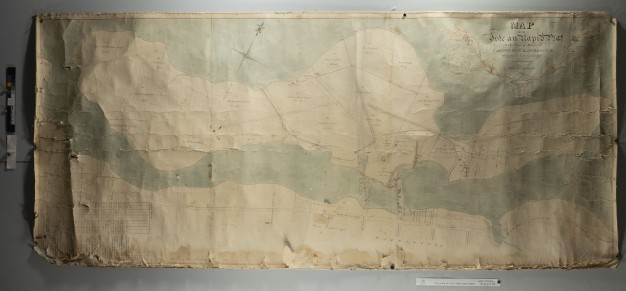Stabilization Treatment of a Map
Sometimes a project arrives in the conservation lab as a mystery. It might be damaged, so in order for the cataloguers and librarians to safely handle it and research its origins, it needs to be stabilized first. For instance, when this map arrived on my bench, it was rolled up tightly. As I tried to unroll it, parts of it kept springing up and detaching from the fabric it was glued to, further deepening its mystery. It had cracks everywhere and it was hard to know what the map depicted.
I rolled it out on my bench and put some weights to hold it in place. It turned out to be a beautiful watercolor and ink map by surveyor Robert Tate of the small towns Ogden and Waddington in upstate New York from 1837.
One of my goals for treatment was to remove the fabric lining on the back since so much of the map was detaching from the fabric already. Before I did that, though, I needed to set down the map on the front so that it stayed whole once its lining was removed, similar to placing Band Aids across the cracks.

My lab-made “Band Aids” consisted of thin, light Japanese mulberry paper and a thin paste made from wheat starch. The paste is water-soluble, so I could take it off later with a little water.
After I applied my “Band Aids,” I took off the fabric lining by gently pulling it off the map. But it still needed some sort of lining to hold it together, so I decided to do a paper lining. In paper conservation today, we prefer paper linings over fabric because they are lighter and more compatible with the paper map.
I enlisted the help of Associate Conservator Renée Wolcott and Willman Spawn Conservation Intern Joanna Hurd to help me line this big map.
And the results were great! I took the “Band Aids” off, and the map was flat and finally legible – ready for research!



